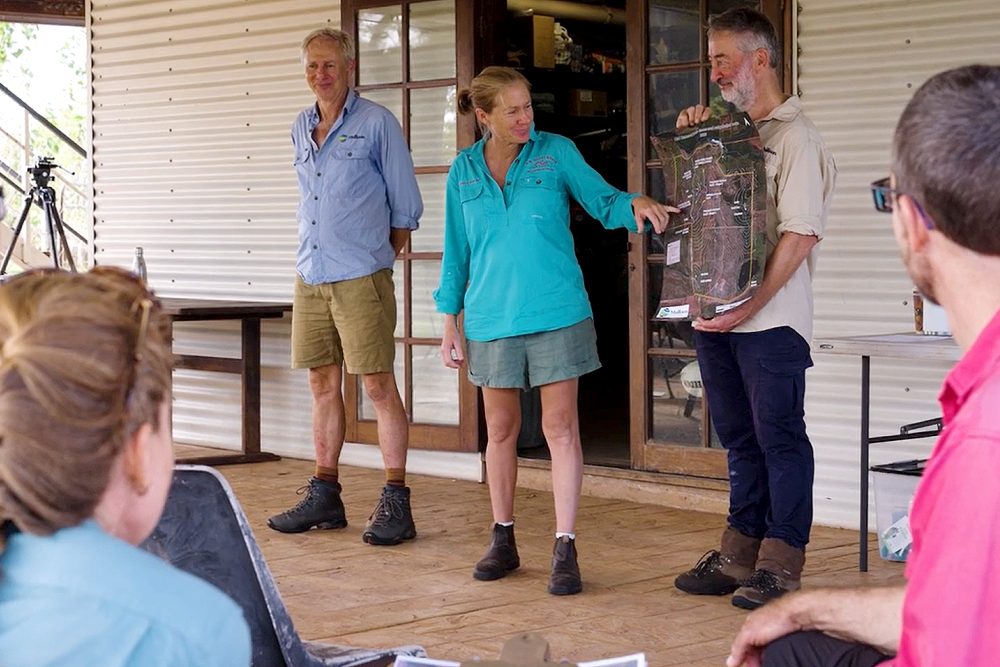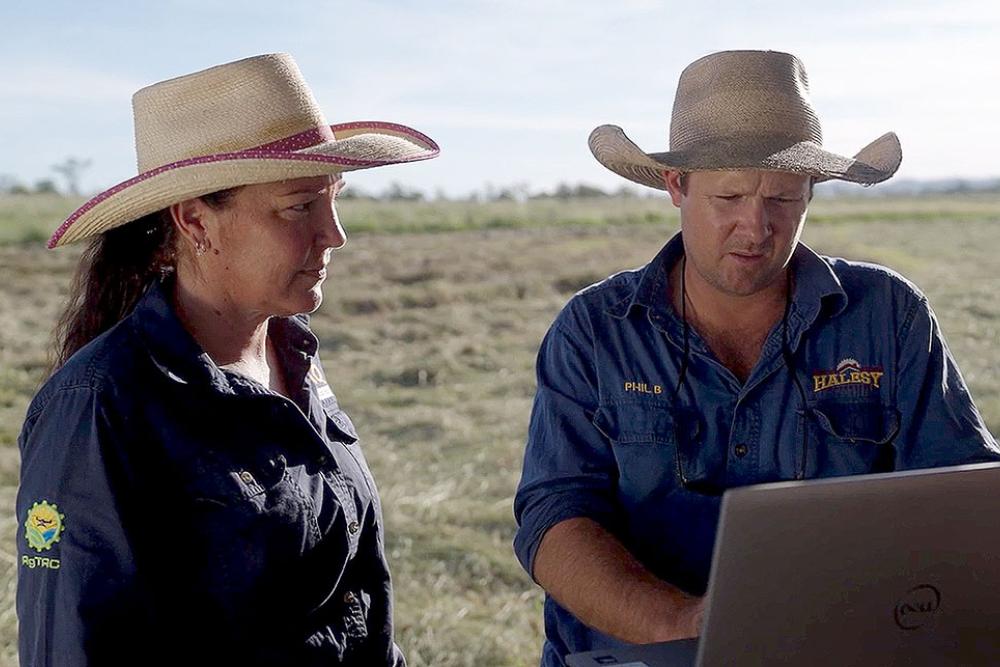Seeing the impact of climate variability on their beef and hay production business in Central Queensland, Matt and Justine McLeod knew they needed to adapt their practices.
“When we first came here, a shower of rain or a storm would end up down the creek not staying in our paddocks,” Matt said.
“We had to irrigate for short periods of time because otherwise the water would just run out of the paddock.”
Leveraging support from the Future Drought Fund’s Natural Resource Management Drought Resilience Grants Program, the McLeods carved out 40 acres to experiment with multi-species cropping and various biological fertilisers to improve their soil water retention.
The large-scale trial yielded some significant gains and cost-savings for the McLeods.
“The differences you see over the 96 plots is unbelievable. The soil is like chocolate cake. When we do apply the worm juice on our lucerne paddock, we get quite a bit more yield—sometimes up to 25 per cent. Our soil over there has got life in it,” Matt said.
They’ve also been able to keep more moisture in the soil.
“You don’t see the same amount of runoff,” Justine said. “It actually absorbs into the soil. Whatever rain falls, we end up catching it.
“We know we’re making a difference because we’re not watering as often, and if we’re not watering as often, it doesn’t cost as much to produce. We know we’ve got enough water. We can actually make it from one rainfall to the next.”
Now, the McLeods are working with Daniel Rea from the Fitzroy Basin Association to share their findings with their neighbours.
“Part of our role, through the Tropical North Queensland Drought Resilience Adoption and Innovation Hub, is to share the learning,” Daniel said.
“Getting boots on the ground and fingers in the dirt and seeing the difference out in the paddock.
“What we like to do is connect people and really make that community of practitioners that are trying to shape the way that farming is done in Australia in the future.”
See how Matt and Justine built their drought resilience from the ground up
Video duration 4 mins 6 secs
Introduction
This is the transcript of a video case study produced by the Australian Government’s Future Drought Fund. Learn more about the Future Drought Fund’s Natural Resource Management Drought Resilience Grants Program.
Transcript
[Recording begins]
Daniel Rea [0:25]:
Obviously, the Future Drought Fund is a huge investment in agriculture in Australia. And the thing that we're most excited about is the focus on preparedness. Because we all know the next drought is just around the corner. We've got some of the most innovative farmers in the world in Australia, and being able to get them to try out all of the things that they want to work on is really exciting.
Matt McLeod [0:45]:
We're here at Lake Pleasant. We're in the Callide Valley area, just Rockhampton-side of Biloela.
Justine McLeod [0:51]:
It's quite volatile here, so we tend to get a lot of rain and then really big spells that are dry. Matt McLeod [0:58]: When we first come here, a shower of rain or a storm would end up down the creek not staying in our paddocks. We had to irrigate for short periods of time because otherwise the water would run outta the paddock.
Justine McLeod [1:06]:
It’s getting drier and we're getting much more, you know, unpredictable weather. So, how do we survive in the area we’re in? Originally, I'm like, ‘We've just gotta catch it, right?’. Like, you know, build big dams and catch it and irrigate. The more I've learned and the more I've gotten into it, I'm like, well, it's not about catching it. Instead of creating all this energy and wasting all of this effort where you then get transpiration, you lose so much of it. How do you actually get nature to work with you and then get nature to hold onto it for us?
[1:33]:
One variable we wanted to look at was monoculture versus multi-species. Another one was compost versus no compost. Another one was worm juice and then also the synthetic. Could we make it practical and large scale, so it's not like some sort of tiny test plot. So, it's literally 40 acres that we ended up carving out and putting aside for the trial.
Matt McLeod [1:52]:
For the Future Drought Fund, they've made it very doable in a short amount of time. The differences you see over the 96 plots is unbelievable. The soil is like chocolate cake. You also notice, when we do apply the worm juice on our lucerne paddock, that we do get quite a bit more yield. So, sometimes up to 25 per cent. We can go over to the paddock that have had the bioferts applied and the soil in there is amazing. It's fluffy, the roots are holding it, there's fungi on our roots. Our soil over there has got life in it. We've created this home for the right insects, the right grubs, the right bugs.
Justine McLeod [2:36]:
In terms of preparing for the drought, there's probably three key takeaways. One is that, you know, you wanna create that soil sponge, so it all sort of sits in there and stays green for longer. And what we notice is that multi-species stays green for longer. The other thing is because the organic carbon increased in the multispecies, we saw that the water efficiency was better. The other one is the runoff. So, you don't see the same amount of runoff and it actually sort of absorbs into the soil. So, yeah, whatever rain falls, we end up catching it. I like the fact that it was so clearcut: multi-species; invest more in your soil; better water retention; better profitability.
[3:10]:
We know that we're making a difference because we're not watering as often, and if we're not watering as often, A, it doesn't cost as much money to water. B, we know that we're gonna have enough water, we can actually make it from one rainfall to the next.
Matt McLeod [3:21]:
It's about showing people that, hey, this can really happen if you just make the change.
Daniel Rea [3:26]:
So, part of our role at FBA—through the Drought Hub and supported by the Future Drought Fund—is to be able to share the learnings and actually getting people, boots on the ground. You know, getting their fingers in the dirt and seeing the difference that it's making outin the paddock. The energy that's created around the field days and the open days and sharing the learning is really important. What we like to do is connect people and really make that community of practitioners that are trying to shape the way that farming is done in Australia in the future.
[Recording ends]



